Lesson 1: Predisposition, Biological Factors, and the Brain
| Site: | MoodleHUB.ca 🍁 |
| Course: | Abnormal Psychology 35 RVS |
| Book: | Lesson 1: Predisposition, Biological Factors, and the Brain |
| Printed by: | Guest user |
| Date: | Thursday, 30 October 2025, 1:14 AM |
Section/Lesson Objectives
The student will ...
• Understand and describe how predisposition, biological factors, and the brain interact to cause abnormal behaviour [This lesson]
• Determine the genetic syndrome a person has from evaluating his or her karyotype [This lesson]
• Describe what constitutional liabilities are and how they relate to mental illnesses [This lesson]
• Explain how nutrition affects mental health [This lesson]
• State how physical deprivation can negatively affect mental health [This lesson]
• Give examples of how psychosocial factors affect behaviour
• Describe the Johari window and apply it to different scenarios
• Discuss the effects of bullying
• Differentiate between the way various cultures view abnormalityy
• Understand and describe how sociocultural factors affect mental health
Introduction
In the lesson content you will come across some terms in maroon color that are bolded. Look them up in the course Glossary.
Terminology
For a person to go to bed one night as “normal” and then wake up the next morning with some form of mental illness would be unusual. Mental illness rarely resembles a light switch – normal one minute, then, with a flick of the switch, abnormal the next. To some degree everyone has vulnerabilities with respect to behaviour. Whether these vulnerabilities affect our behaviour in a negative way depends on the nature, number, and degree of the vulnerabilities we have, combined with the stressors we face in our lives.
 In psychology, the term predisposition is often used when discussing abnormal behaviour. Predisposition is the tendency of a person with vulnerabilities to develop a psychological disorder given the appropriate environmental circumstances. These circumstances, or stressors, need not be the same for each person. Vulnerabilities also vary widely. For example, one can have biological or genetic vulnerabilities, experiential vulnerabilities (traumatic events in childhood), or skill deficit vulnerabilities (poor or non-existent coping mechanisms).
In psychology, the term predisposition is often used when discussing abnormal behaviour. Predisposition is the tendency of a person with vulnerabilities to develop a psychological disorder given the appropriate environmental circumstances. These circumstances, or stressors, need not be the same for each person. Vulnerabilities also vary widely. For example, one can have biological or genetic vulnerabilities, experiential vulnerabilities (traumatic events in childhood), or skill deficit vulnerabilities (poor or non-existent coping mechanisms).
In addition to predisposition and vulnerability, the concepts of primary cause and precipitating cause are important when discussing reasons for abnormal behaviour. Although not always obvious to an observer, all mental illnesses have primary causes. For a person with hoplophobia (a fear of guns), the primary cause could be that he or she witnessed a gun-related murder as a child. Precipitating causes are like a collection of children’s building blocks being stacked one upon the other until a point at which, if even the smallest block is added, the entire pile falls to the ground. In this example, the last block is the precipitating cause of the fall of the structure. When comparing building blocks with human stressors, the size and number of total blocks before the collapse differs for each person.
Biological Causal Factors in Abnormal Behaviour
All behaviour, abnormal or not, is controlled by biochemical processes. Biological factors affect all aspects of behaviour including intellectual capabilities, temperament, stress tolerance, and more. The act of reading this paragraph is activating numerous sensory processes (feeling the paper, having your retinas receive electromagnetic radiation or light), motor processes (moving your eyes, changing the amount of light allowed into your eye), and neuronal processes (the conduction of nerve messages), all of which are mediated by chemical transmissions. Understanding these processes, however, does not account for your motivation to read the information and then think about or understand what is written. To understand these (motivation, thinking, and understanding), one must address the psychological processes driving the behaviour. Biological factors can be categorized into four main areas. Please refer to Figure 5.1 for a graphical overview.

Genetics
Each of the four main categories of biological factors encompass a number of conditions that affect the quality and function of our bodies. They are not always independent of each other, and they occur in various combinations throughout the general population. The first category, genetics, reminds us that no two people have exactly the same genes - the exception being identical twins. Genes are the long molecules of deoxyribonucleic acid (DNA) that occur at various locations on chromosomes. Each individual has 23 pairs of chromosomes, and each chromosome usually contains over 60 000 genes that contribute to the physical and psychological distinctiveness of individuals. When a baby is conceived, he or she receives 23 chromosomes from the mother and 23 chromosomes from the father. This means, for each characteristic or trait an individual has, there are two sets of instructions. These individual sets of instructions for the same trait are called alleles.
The instructions in the alleles from each parent can be the same or different. For example, one parent may have straight hair and the other parent may have curly hair. The expression of these competing genes is determined by whether the genes or alleles are dominant or recessive. Some genes, like those for curly hair, are described as dominant. When linked with other instructions, they are expressed and the recessive genes are suppressed. A recessive gene (e.g., straight hair) is expressed only when matched with another recessive gene with identical instructions. Biologically speaking, the development of most mental illnesses is associated with recessive genes. If mental illness were the result of dominant genes, the expression in each generation would be practically guaranteed, resulting in a continuing disadvantage.
 Many disorders are thought to be the result of a combination of genes instead of a single one. Problems may also arise if a gene is absent rather than present. An important point is that having a gene that has been linked to an illness this does not mean you will certainly acquire the illness. The opposite is also true. If a person does not possess the gene that has been linked to an illness, that person may not be safe from getting the disease. Mental illness is often far too complicated for simple links and associations! Behaviour, unlike physical characteristics (e.g., straight hair versus curly hair), is the result of the interaction among genes, hormones, and the environment.
Many disorders are thought to be the result of a combination of genes instead of a single one. Problems may also arise if a gene is absent rather than present. An important point is that having a gene that has been linked to an illness this does not mean you will certainly acquire the illness. The opposite is also true. If a person does not possess the gene that has been linked to an illness, that person may not be safe from getting the disease. Mental illness is often far too complicated for simple links and associations! Behaviour, unlike physical characteristics (e.g., straight hair versus curly hair), is the result of the interaction among genes, hormones, and the environment.
Problems with entire chromosomes can also result in abnormalities. Humans have 46 chromosomes in all cells except the reproductive (sex) cells. These 46 chromosomes are divided into 23 pairs. Twenty-two of these pairs are called autosomes; they determine general structural and physiological characteristics. The remaining pair of chromosomes are the sex chromosomes. In human females, both of the sex chromosomes are designated X, while in the male, one chromosome is an X and the other is a Y. With each gender, male or female, the mother donates an X to her offspring. The other chromosome comes from the father. It can be either an X or a Y. If it is an X, the offspring is female. If the chromosome is a Y, the offspring is a male. In humans, the male determines the gender of the offspring.

Chromosomal Abnormalities
Major difficulties arise if not exactly 23 pairs are present in the offspring. Down syndrome, for example, 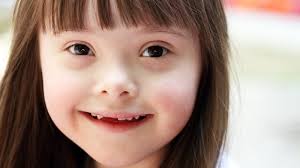 results when a trisomy (three not two) of chromosome pair 21 occurs. Problems also occur if one chromosome from a pair is missing. Turner syndrome, for instance, is a condition in the sex chromosomes where a female has only one X (monosomy). When a scientist takes a sample of a person’s chromosomes and arranges them into pairs, the arrangement is called a karyotype. In a karyotype, any chromosomal anomalies may then be seen. Please see Figure 3-1 for an example of a karyotype.
results when a trisomy (three not two) of chromosome pair 21 occurs. Problems also occur if one chromosome from a pair is missing. Turner syndrome, for instance, is a condition in the sex chromosomes where a female has only one X (monosomy). When a scientist takes a sample of a person’s chromosomes and arranges them into pairs, the arrangement is called a karyotype. In a karyotype, any chromosomal anomalies may then be seen. Please see Figure 3-1 for an example of a karyotype.
Please click on the web site below to learn more about chromosome abnormalities and Down syndrome.
| https://www.stanfordchildrens.org/en/topic/default?id=types-of-chromosome-abnormalities-90-P02158 |
The following karyotype shows the 23 sets of chromosomes. Notice the trisomy in pair 18. This trisomy is called Edwards syndrome, which results in severe heart malformations. Also notice the monosomy of chromosome 23. This female has Turner syndrome. Extreme chromosomal abnormalities often result in spontaneous abortions or stillbirths.
Figure 3-1: Karyotype for Turner and Edwards Syndrome
Learn more about Turner's syndrome by watching this short video:
Edwards Syndrome:
Klinefelter Syndrome
For characteristics of various chromosomal anomalies, please see Table 3.2.
Table 3.2: Chromosomal Anomalies
|
Pair |
Number of Chromosomes | Characteristics of Affected Individual |
| 13 | 3 | This fatal condition is associated with major brain abnormalities. |
| 18 | 3 | Edwards Syndrome: This fatal condition is associated with severe heart malformations. |
| 21 | 3 | Down Syndrome: This condition results in mental retardation or handicap; individuals may have slanted eyes and a flattened face. |
| 23 | 3 | Klinefelter Syndrome: Males have one Y and two X chromosomes. They have underdeveloped testicles and a lack of body hair. One of five may have a mental handicap. |
| 23 | 1 | Turner Syndrome: Females have only one X chromosome. They are generally short, have webbed necks, and have underdeveloped ovaries. |
Table 5.2: The Gene Pool (Jeff Holubitsky, 1996)
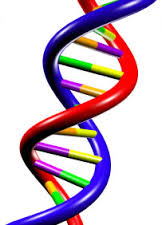
• Children inherit 50 percent of their genes from each immediate biological parent, 25 percent from each grandparent and so on down the line.
• In the long run, siblings are likely to share about half of this genetic information, but it could be more or it could be less.
• Twin studies have shown that although twins are called identical, they rarely are.
• Most experts in behaviour genetics believe that most human characteristics are determined by both the genetic inheritance and the life experience of the individual.
• There are about 30,000 genes that are distinct proteins in the brain and 20,000 are specific to the brain.
• Because of all the combinations and cross-overs in the chromosomes, parents could theoretically produce thousands of children and no two would be genetically identical.
• Many conditions such as cystic fibrosis, Huntington’s Chorea, and Tourette syndrome appear to have genetic links. Once a disease is determined to have a genetic cause, that information can lead to treatment. Currently, the genes can’t be changed, but the genes aren’t causing the consequences – proteins, enzymes and cells do, and they can be altered.
• Researchers also suspect some broader conditions such as dyslexia may have a genetic origin. If that’s the case, early diagnosis could lead to more effective teaching methods for these children.
• Genetic researchers are examining schizophrenia and depression, but these conditions are difficult to clinically define, unlike specific physical ailments.
• A minority of Alzheimer’s cases appear to be associated with a defective gene, however, most cases don’t appear to have a genetic cause.
Misunderstood condition marked by sudden rage
 A last example for this section is Fragile X syndrome. This syndrome is a rare genetically linked disorder that affects the mental ability of its sufferers and may make individuals overly aggressive. It is caused by a mutation of a gene on the X chromosome, the symptoms of which often resemble those of autism, hyperactivity, and attention deficit disorder. Please review the following article that describes the experiences of one family dealing with Fragile X syndrome. (Susan Ruttan, Edmo)
A last example for this section is Fragile X syndrome. This syndrome is a rare genetically linked disorder that affects the mental ability of its sufferers and may make individuals overly aggressive. It is caused by a mutation of a gene on the X chromosome, the symptoms of which often resemble those of autism, hyperactivity, and attention deficit disorder. Please review the following article that describes the experiences of one family dealing with Fragile X syndrome. (Susan Ruttan, Edmo)
Aggressive, autistic, and affectionate are just a few ways to describe the Smiths’ three children.
When strangers glare at her often-unruly children, Jane Smith has a ready response. She’s given it so often that she’s had it printed up on a business card to hand out.
|
“I am sorry if some of the noises I make or the things that I do distract you or bother you,” it says. “I am not doing them on purpose. I have fragile X syndrome, and this causes me to do some things that I don’t have any control over…” |
“Things can happen right out of the blue,” said mom Jane in an interview in the family home”.
To have a child with fragile X syndrome, say parents, is to face endless ignorance and misunderstanding about the genetically inherited condition that so severely affects their child.
Raising three children with fragile X, as Jane and John Smith have, is a burden to daunt all but the most dedicated parents. The Smiths’ three children, nine-year-old identical twins Bill and Ted and their little sister Joan, six, look like blond, bubbly angels.
Watching the kids at home after school, with Bill and Ted drawing pictures in the living room and Joan playing with her Barbies in her bedroom, they appear unexceptional.
Only the frantic, exhausting pace of their play, the twins’ limited speech, and the scratches on Joan’s arm hint at the challenges they pose.
Fragile X syndrome causes mental retardation and a variety of behavioral problems that may include autism and aggression. The mix of problems in each fragile X child is different; what unites them is a genetic test that proves they have the syndrome.
In the Smith’s family, all three of their children can burst into sudden rages, especially Bill and Joan.
Each of them may attack their siblings, destroy the furniture or hurt themselves. And of course, one raging child sets off the others. Three siblings with fragile X are more than the sum of their parts.
Constitutional Liabilities
Behavioural difficulties that appear to be genetic but are not the result of gene or chromosome abnormalities can often be attributed to constitutional liabilities. The word constitutional describes those characteristics that were acquired during development in the uterus and not through heredity. A liability refers to something that is a disadvantage to an individual. In short, a constitutional liability is a characteristic acquired in utero that is a disadvantage to the individual.
The first of three main types of constitutional liabilities relates to the physique or the form and structure of the human body. Attractive people, generally speaking, have advantages in life not shared by less attractive people. One need only look at the rich and famous to see that the majority of people in this category are attractive. Studies have shown that even incorrect impressions that a person is unattractive may enhance the risk of disorder (Noles, Cash, & Winstead, 1985). In extreme cases, some individuals undergo cosmetic surgery time and time again to correct perceived physical liabilities.
The second type of constitutional liability is physical handicaps. The results of embryologic problems (e.g., cleft palate, spina bifida), or drug-related effects (e.g., fetal alcohol spectrum disorder, central nervous system defects) are obvious, but the causes of many of the handicaps are not known.
This video provides some interesting information on fetal alcohol spectrum disorder, which is caused by the mother drinking alcohol while pregnant. This disorder is 100% preventable and leaves the baby with a life long struggle, as many of the neurons in their brain are destroyed before they are even born.
Although it may be heartbreaking for parents to see their newborn with any deformity, cosmetic surgery for cleft palates can be quite effective. See Table 4.1 for “cleft facts” (Gordon Wilkes, 2004) and Figure 4.2 for a picture of a child with a cleft lip.
Table 4.1: Cleft Facts
|
• One in 700 babies are born with a cleft lip and/or palate. It occurs more often (one in every 350 births) among Asians and certain groups of native North Americans. • A cleft lip occurs between the fourth and sixth weeks of pregnancy when portions of the upper lip do not fuse. A cleft palate occurs between the eighth and 12th week of pregnancy when the structures between the mouth and the nose fail to come together. • 50 percent of patients have a cleft lip and palate; 30 percent only have a cleft palate and 20 percent only have a cleft lip. • A cleft lip and cleft palate are more common in males. • A cleft palate alone is more common in females. • Only 30 percent of cleft lips and/or palates are hereditary. • In the majority of cases the cause is unknown, but the risk is higher if the mother takes certain anticonvulsant drugs such as phenytoin during pregnancy, if she smokes or drinks heavily. • If you have one child with a cleft lip, the chances of the next child having a cleft lip too is one in 25. If one child has a cleft palate, the chances of the next child having a cleft palate is one in 50. • The Chinese were the first to surgically repair cleft lips in 400 A.D.. A lack of antibiotics and other technical know-how delayed the first surgical repair of a cleft palate until 1861 in Germany. |
Figure 4.2: A cleft lip is a separation of the upper lip that can extend into the nose.

The last type of liability refers to primary reaction tendencies. Babies differ in how they react to various  stimuli. Some babies are easily startled while others are quite placid. The differences in reactions are examples of primary reaction tendencies. The way the babies react appears to have been established before birth, some of which may be related to early hormonal influences in utero. Current studies suggest the mix of hormones before birth relate to gender preferences. The power of hormones!
stimuli. Some babies are easily startled while others are quite placid. The differences in reactions are examples of primary reaction tendencies. The way the babies react appears to have been established before birth, some of which may be related to early hormonal influences in utero. Current studies suggest the mix of hormones before birth relate to gender preferences. The power of hormones!
Brain Dysfunction
Effective brain functioning relies on the way nerve cells (neurons) transmit their messages across synapses (junction points) to the next neurons. Neurons are specialized in their shape and position. The neurons do not touch each other. Small gaps, called synapses, lie between neurons. To get a message across a synapse, neurons release chemicals called neurotransmitters. An electrical impulse travels along a neuron, but when it reaches the end of the neuron, instead of the electrical impulse travelling into the next cell, neurotransmitters are released. These neurotransmitters then travel into the synapse between the two neurons, seeking a specialized receptor where they can fit onto the next neuron. We have many types of neurotransmitters, and they are all shaped differently. To have an effect on another neuron, the neurotransmitter must fit into a site specifically designed for them. To visualize this process, think of the way that your house key can open only the door to your own house.
Different neurotransmitters have different effects in the body, but all neurotransmitters must be working properly for a person to be able to sleep, move, and even maintain a positive outlook on life. The following are some of the neurotransmitters found in the human body.
Acetycholine - functions in the parasympathetic division of the nervous system and helps to return increased heart rate to normal.
Dopamine - found in areas of the brain that manage movement, emotional arousal, learning, and memory.
Epinephrine - (both a hormone and neurotransmitter) increases heart rate and blood pressure
Serotonin - produced in the central nervous system and has a role in sleep and emotional arousal. Lack of serotonin production or availability in the synapses is thought to be responsible for severe depression in some individuals. People suffering from depression find difficulty experiencing any uplifting emotions or happiness. They may also have a very difficult time sleeping. Antidepressants, drugs that are chemically designed to keep serotonin in the synapse long enough to attach to another neuron and have its proper effect, have been used with great success in alleviating severe depression.
| Neuron | Synapse with Neurotransmitters |
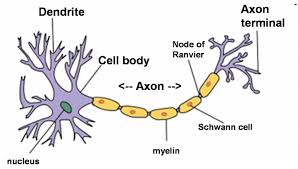 |
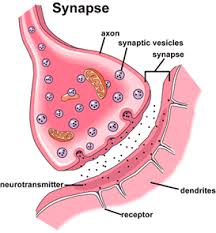 |
Examples of disorders relating to brain dysfunction include Alzheimer’s, Parkinson’s, epilepsy, and Creutzfeldt-Jakob disease. The Internet provides the most current information on Creutzfeldt-Jakob disease.
Epilepsy
Epilepsy is a neurological disorder that occurs when abnormal electrical impulses occur in the brain. The impulses may involve the body seizing or convulsing. Seizures may occur randomly, and most are accompanied by a loss of consciousness. Some people may experience seizures many times per day while others may have years go by between seizures. Doctors believe that some epileptic seizures are caused by high fevers or infection, but other seizures seem to occur randomly with no specific detectable causes. Epilepsy is thought to have genetic links because it is more likely to appear in families. Treatment may involve medication that prevents convulsions. In severe circumstances, brain surgery may be an option. If the aberrant impulses are specific to certain areas of the brain, the brain surgery may involve cutting certain neural connections, thereby preventing the abnormal electrical impulses from affecting areas they should not.
Parkinson’s Disease
Parkinson’s disease occurs when a specific part of the brain starts to degenerate. This section, called the 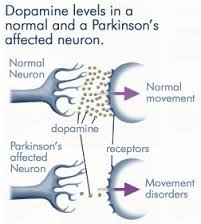 Substantia Nigra, contains cells that release the neurotransmitter dopamine that is thought to have some role in controlling movement. The symptoms of Parkinson’s disease include shaking, muscle rigidity while at rest, involuntary movements, inability to maintain a body position, difficulty moving, and problems producing speech.
Substantia Nigra, contains cells that release the neurotransmitter dopamine that is thought to have some role in controlling movement. The symptoms of Parkinson’s disease include shaking, muscle rigidity while at rest, involuntary movements, inability to maintain a body position, difficulty moving, and problems producing speech.
The main challenge researchers face in developing a cure for Parkinson’s is finding some way to stop the degeneration of the Substantia Nigra. Until a cure for the degeneration can be discovered, doctors must treat this disease with medication that enables the body to keep dopamine in its system.
Physical Deprivation
 People require food, air, water, sleep, and other fundamental components to survive. These are the basic needs of all humanity. If such essential components are interfered with for a prolonged period of time, the ability to deal with stress drops dramatically. Prisoners have sometimes been “broken” by nothing more persuasive than the systematic prevention of sleep or deprivation of food over several days (Carson, Butcher, Coleman, 1988). Experimental studies where volunteers deprived themselves of sleep for over three days (up to 98 hours) showed that the subjects became disoriented, irritable, anxious, paranoid, and unable to concentrate. Another study on semi-starvation (Keys, 1950) is illustrated.
People require food, air, water, sleep, and other fundamental components to survive. These are the basic needs of all humanity. If such essential components are interfered with for a prolonged period of time, the ability to deal with stress drops dramatically. Prisoners have sometimes been “broken” by nothing more persuasive than the systematic prevention of sleep or deprivation of food over several days (Carson, Butcher, Coleman, 1988). Experimental studies where volunteers deprived themselves of sleep for over three days (up to 98 hours) showed that the subjects became disoriented, irritable, anxious, paranoid, and unable to concentrate. Another study on semi-starvation (Keys, 1950) is illustrated.
|
Thirty-two conscientious objectors served as volunteer subjects. The men were first placed on an adequate diet for three months, then placed on a very low calorie diet characteristic of European famine areas for a period of six months, and then provided with a three-month period of nutritional rehabilitation. During the six-month period of semi-starvation, subjects had an average weight loss of 24 percent. At the same time, subjects also showed dramatic personality and behavioral changes. They became irritable, unsociable, and increasingly unable to concentrate on anything but food. In some instances they resorted to stealing food from one another and lying in attempts to obtain additional food rations. Among other psychological changes were apathy, loss of pride in personal appearance, and feelings of inadequacy. By the close of the experiment, there was a marked reduction or disappearance of their interest in sex, and the predominant mood was one of gloom and depression. Food dominated the men’s thoughts, conversations, and even daydreams. They even pinned up pictures of chocolate cake instead of pretty women. In some cases, they went so far as to re-plan their lives in the light of their newly acquired respect for food. The investigators concluded that by the end of the twenty-fifth week, hunger had become the dominant influence in the behavior of their subjects. |
Besides the example of hunger, one can also think of trying to carry out a normal workload or schedule when very ill with a flu. Both our ability to cope and our behaviour are negatively affected.
The second component of physical deprivation is stimulation – or rather, the lack thereof. The importance of stimulation received by an infant is crucial to healthy development. Since the 1940s, researchers have known that a child who receives inadequate stimulation is at risk for emotional difficulties. In fact, some institutionalized infants (orphans) who did not receive attention and human contact, wasted away and died. The consequence of infant death due to lack of stimulation was termed hospitalization syndrome. A study, performed by Harry Harlow in 1966, involved rhesus monkeys. This study showed the importance of love and attention in the development of offspring. The experiment was, unfortunately, cruel and unethical; for humane reasons it would not be performed by scientists in North America today.
The Brain and Nutrition
Our biological health requires basic nutrition; one of our fundamental needs is food. Food and drink, however, can be healthy or unhealthy. A child raised on hot dogs and soft drinks would be lacking in complete and balanced nutrition. The body (especially the brain) needs special materials for it to operate effectively. Like a car that needs oil, gas, and antifreeze to operate, our bodies need vitamins, minerals, and glucose. Our bodies are more particular, however. Too much or too little of a vitamin, for instance, can result in problems with our development. Some vitamins are water-soluble (e.g., vitamin C); if we ingest too much, we excrete what we do not use (usually in our urine). Other vitamins are fat-soluble (e.g., vitamin D). If we ingest too much, we gradually build up toxic levels of the compound in our fat cells. See Table 6.1 for specific examples.
TABLE 6.1
|
Vitamin |
Foods |
Symptoms |
|
A fat soluble |
Found in fish liver oils, liver, egg yolks, butter, cream, green leafy vegetables, and yellow vegetables. |
In childhood, a severe deficiency may cause problems with the cornea (part of the eye), night blindness, and in extreme cases, total and permanent blindness. Too little can also cause dry skin in adults. Too much vitamin A may result in sparse coarse hair, dry rough skin, cracked lips, severe headache, vomiting, joint pain, and generalized weakness. |
|
D fat soluble |
While this vitamin is naturally found in fish liver oils and egg yolks, it has been added to most milk. This vitamin is formed in human skin by exposure to sunlight (ultraviolet radiation). |
Bone development problems arise with a lack of vitamin D. Walking may be painful and rickets may develop. Too much of this vitamin may cause constipation, loss of appetite, and headache. |
|
E fat soluble |
Found in plant oils (vegetable oil, margarine, salad dressings), dark green and leafy vegetables, whole grain cereal products, liver, egg yolks, milk fat, nuts, seeds, and butter. |
To have too much or too little of this vitamin is rare. In extreme deprivation some red blood cells may rupture. With an overdose of this vitamin, some people may experience intestinal disturbances. |
|
K fat soluble |
Vegetables provide the major amount of this vitamin in the diet, but nutritionists have assumed that people absorb more from oil or oil-based supplements than from vegetables. |
Deficiency may interfere with the process of blood clotting. Too much of this vitamin in infancy may cause jaundice. |
|
|
|
|
|
C water soluble |
Fruits (especially citrus) and vegetables are the best sources. |
Lack of this vitamin causes scurvy; one major result of scurvy is the failure of wounds to heal. Lack of vitamin C also stops bone growth. Too much vitamin C may increase the likelihood of kidney stones, the destruction of vitamin B12, and diarrhea. |
|
B12 water soluble |
Animal products are the best source. Vegetables do not provide adequate B12 vitamins. |
Too little B12 causes pernicious anemia. A person may experience a loss of sensation in the fingers and toes. B12 has low toxicity and, generally speaking, no negative results occur from too much of this vitamin. |
|
B1 (thiamine) water soluble |
Found in brewers yeast, pork, sunflower seeds, peas, and beans |
A deficiency in thiamine results in lower glucose utilization by the nervous system, degeneration of the myelin sheaths of certain nerve fibres, a weakened heart muscle, beriberi, and constipation. Too much of this vitamin, if injected, can cause a nervous system hypersensitivity reaction. |
|
B3 (niacin) water soluble |
Tuna, chicken, beef, and many other foods contain niacin. |
A lack of niacin can result in muscle weakness, decreased glandular secretions, and inflammation of the gastro-intestinal tract. Too little can also cause a skin rash on areas exposed to the sun. Too much niacin can result in “niacin flush” (reddening of the skin), heartburn, nausea, diarrhea, fainting, and liver malfunction. |
|
B2 (riboflavin) water soluble |
Foods high in riboflavin include milk, yogurt, cheese, meat, leafy green vegetables, whole and enriched grains. Riboflavin is an essential vitamin and is easily destroyed by light. Oral contraceptives may cause riboflavin deficiency as well. |
With low levels of riboflavin, people may experience cracking at the corners of the mouth, burning eyes, depression, headaches, and forgetfulness. No cases of toxicity are reported regarding this vitamin. Note: Riboflavin can be destroyed by light. Do not keep milk in clear containers in the light! |
|
Folate (one of the B vitamins) water soluble |
Folic acid, also called folacin, is found in spinach, asparagus, turnip greens, lima beans, beef liver, parsley, broccoli, and romaine lettuce. |
Low levels of folic acid have negative consequences for developing fetuses because folate is necessary for the production and maintenance of new cells. This is especially important during periods of rapid cell division and growth such as infancy and pregnancy. Folate is needed to make DNA and RNA, the building blocks of cells. It also helps prevent changes to DNA that may lead to cancer. Both adults and children need folate to make normal red blood cells and to prevent anemia. Low folate in utero is linked to spina bifida. Negative effects have not been found with too much folate. |
|
B6 (pyridoxine) water soluble |
This vitamin can be found in fortified cereals, beans, meat, poultry, fish, and some fruits and vegetables. |
Low levels of this vitamin can cause anemia as well as a decrease in antibody production and suppression of the immune system. Some people may also experience dermatitis, a sore tongue, depression, and confusion. Too much B6 can cause neurological damage. |
Some vitamins and minerals required by our bodies are not naturally produced by our bodies. Using the food we eat, the body must manufacture these substances that include proteins and fats. The body does this by digesting the proteins and fats in food to make special proteins and fats for our brains to use. Not all fats are created equal, however. The “good” fats or lipids include the omega-3 and omega-6 fats. Low levels of such fats can cause visual problems as well as problems in motivation and motor co-ordination.
 |
 |
 |
As referred to previously, neurotransmitters are an important part of brain functioning. Certain foods contain essential components responsible for the functioning of neurotransmitters. If a person’s diet is lacking in the required foods, neurological and emotional disorders may occur. See Table 5.5 for examples of some essential components.
TABLE 6.2.
|
Essential Component |
Used to Make | Source |
| Aspartic Acid | Aspartate | Peanuts, potatoes, eggs, and grains |
| Choline | Acetylcholine | Eggs, liver, and soybeans |
| Glutamic Acid | Glutamate | Flour and potatoes |
| Phenylalanine | Dopamine | Beets, soybeans, almonds, eggs, meat, and grains |
| Tryptophan | Serotonin | Eggs, meat, skim milk, bananas, yogurt, milk, and cheese |
| Tyrosine | Norepinephrine | Milk, meat, fish, and legumes |
|
Causes of vitamin and mineral deficiencies are varied.
|
The nutrition of a pregnant woman is important to the development of her fetus. Proper nutrition during the first two years of life is also important. Malnutrition during either of these periods of rapid brain growth may result in developmental difficulties, some of which are not reversible. In addition to proper nutrition, people need to avoid non-nutritive substances that may lead to addiction. The addicted brain is a complicated subject – neurobiologists have known for a long time that certain substances (alcohol, cocaine, even sugar) induce the activity of the brain’s reward system so much so that individuals may do anything to get a “fix” or “hit” of a drug, even at the expense of eating and sleeping! Addiction is discussed further in subsequent lessons.
The importance of nutritional health to mental health
The following two articles connect the importance of nutritional health to mental health. The first article (Robert Boyd, 1997) indicates that the “brain’s wiring begins in the womb”.
| First months of life set mold for young minds |
|
The world’s most complex construction project – building a human brain begins in a tiny sac tucked inside a woman’s body about six weeks after she conceives a baby. That is when primitive structures in the embryo start to churn out the first of billions of brain cells, known as neurons, which eventually will help determine if the infant is to be a kindly professor, a remorseless killer or something in between. Recent dramatic advances in brain science show that the foundation of a child’s intellectual and emotional development is laid long before birth, indeed, even before he or she is conceived. “Life in the womb will be written on your tomb,” Irina Pollard, an expert on the biology of children, said recently at a panel on the subject. Furthermore, biologists and psychologists now believe that the first three years of life are even more important than previously realized. Well-intentioned remedial programs aimed at four and five year olds, come too late to do much good, according to Craig Ramey, a leading authority on early development at the University of Alabama, Birmingham. Making up for a bad start is not impossible, experts say, but it is much more difficult. One of the lessons is that prospective parents have a crucial responsibility to provide a safe environment for their future progeny. Did the father-to-be drink or smoke? Did the expectant mother avoid pesticides and watch her diet? Do Mom and Dad talk and sing to their newborns? Researchers say these questions set the odds on whether a child will do well later in life. A future father’s role is especially important, since a man’s sperm is more easily damaged than a woman’s egg, and flaws can be passed on to succeeding generations. “Genetic abnormalities are more often linked with paternal than with maternal DNA damage,” Pollard said. Although most children turn out all right, she cited studies indicating that babies born to parents who are smokers, heavy drinkers or drug users are smaller, more likely to be mentally retarded, and more prone to cancer and other diseases than the children of people with healthier lifestyles. For example, about two births out of every 1,000 produces a mentally retarded child, worldwide statistics show. Among pregnant women who consume at least two alcoholic drinks a day, however, the rate ranges up to 59 per 1,000 almost 30 times as high. Another recent discovery is an apparent parallel between intelligence and emotion. As neurons develop, some put out branches to organs like the amygdala, an almond-shaped structure deep inside the brain that is associated with feelings such as anger and fear. Experts say a child’s ability to handle such feelings—as well as to read, think or do arithmetic—can be affected by neglect or abuse early in life. This helps understand why seven to 10 year-old kids who have had terrible experiences are able to commit heinous acts with no apparent remorse or concern for their victims, Ramey said. “The evidence is scant, but it could be that their brains are fundamentally wired differently,” he added. “It drives home the importance of early intervention. Society’s welfare is at stake, not just the individual’s”. Many insights flow from work with fruit flies, rats and monkeys, because animals can be put through experiments that would be impossible or unethical with human beings. “Lower organisms tell us more than we ever believed about what’s happening in humans,” said Charles Epstein, a geneticist at the University of California, San Francisco. “Nature grabs a system that works and seems to retain it, all the way from fly to man.” For example, William Greenough, a biologist at the University of Illinois, Champaign/Urbana, discovered that the brain cells of a young rat raised in a lively, complex environment, with mazes and plenty of company, have more branches and interconnections than a rat raised in an isolated cage. The same principle probably applies to people, according to Dr. Norman Krasnegor, chief of the Human Learning and Behavior Branch at the National Center for Child Health and Human Development in Bethesda, Md. “Early intervention can have a salutary effect on later development,” Krasnegor said. “Many people who live in poverty don’t understand how to interact with kids. They just feed them and hope they go to sleep. In Ramey’s studies, he found that children from disadvantaged and normal families score about the same on mental tests until the age of 12 months. After that, however, kids from low-income or troubled homes start to develop at a slower rate. By 24 months, they are behind their better-off contemporaries by the equivalent of 15 points on the IQ scale. “It’s a sleeper effect,” Krasnegor said. |
The second article (Shankar Vedantam, 1997) encourages people to keep their brains active!
| Finding the root of fear…. and other emotions |
|
Scientists are increasingly finding that mental disorders may only be malfunctions of the physical brain, much like a broken ankle, and perhaps, equally curable. The brain is highly specialized, and mental maladies are rooted in specific areas of the brain. Anxiety disorders may affect areas of the brain that govern emotion; schizophrenia (affects) areas that govern hearing and sight. “By knowing where in the brain things may go wrong in mental disorders, we can target rationally designed treatments,” said Steven Hyman, director of the National Institute of Mental Health. “We’re actually beginning to localize specific emotions in the brain,” he said. One of the first: fear, based in an almond-shaped structure at the front of the brain. “This can help us to design better treatments for anxiety disorders,” Hyman said. And brains, it turns out, don’t act all that different from the rest of our bodies. For instance, the things that keep bodies healthy, a balanced diet, rest and exercise, also keep the brain healthy. Researchers also know that keeping intellectually active, or gaining high levels of education protects people against many brain disorders, the same way exercise helps physical health. “Using your brain prevents disease,” said Joseph Coyle, chair of Harvard University’s department of psychiatry. “A use-it-or-lose-it strategy works in the brain.” Hyman also expects the new understanding of the brain’s workings to pave the way to more acceptance for mental patients. “Once we realize that mental disorders represent specific forms of brain functions,” he said, “the results should be profoundly destigmatizing.” |
Hemispherectomy
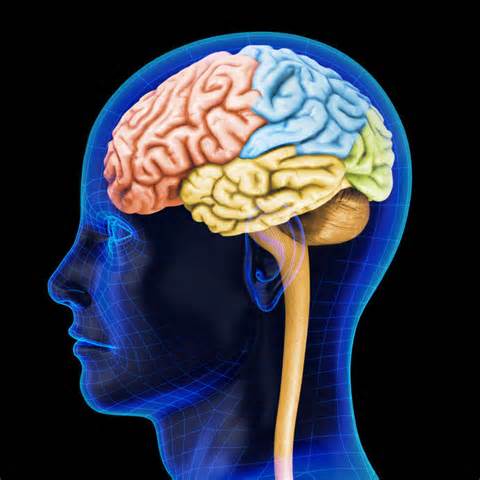 The brain is the organ that makes us unique from other people. It is the organ that orchestrates our behaviour and houses our personalities. The consequences of brain damage can be irreversible. It is possible, however, to improve behaviour and functioning with the removal of a part of the brain. People born with Sturge-Weber syndrome (a disorder of blood vessels in the brain), often suffer from epileptic seizures and may be given medication to control the outbursts. The medication, however, may result in unwanted side-effects. In one case, a boy on medication for epilepsy related to Sturge-Weber had the side-effect of not being able to speak. The boy’s mother, after doing some research, determined with the help of doctors, that the best course of action was to have one half of her son’s brain removed as that half was very badly damaged.
The brain is the organ that makes us unique from other people. It is the organ that orchestrates our behaviour and houses our personalities. The consequences of brain damage can be irreversible. It is possible, however, to improve behaviour and functioning with the removal of a part of the brain. People born with Sturge-Weber syndrome (a disorder of blood vessels in the brain), often suffer from epileptic seizures and may be given medication to control the outbursts. The medication, however, may result in unwanted side-effects. In one case, a boy on medication for epilepsy related to Sturge-Weber had the side-effect of not being able to speak. The boy’s mother, after doing some research, determined with the help of doctors, that the best course of action was to have one half of her son’s brain removed as that half was very badly damaged.
The boy underwent surgery to have half his brain removed - a hemispherectomy. After a speedy physical recovery, the boy was weaned off his medication and soon after said his first words. He no longer had epilepsy nor any of the accompanying behaviour problems. In some cases a hemispherectomy does nothing to improve the life of the affected individual, but many times it does. Sometimes IQ can also improve dramatically. Why this happens and how a person with half a brain can be better off than before is still a mystery.
Lesson Review
The brain is a fascinating subject, don't you think?
|
To summarize: • Predisposition is the tendency of a person with vulnerabilities to develop a psychological disorder given the appropriate environmental circumstances. • Know and be able to explain biological causal factors in abnormal behaviour |
Assignment
Complete the following:
1. S2L1Quiz - You may refer to your lesson while you complete this assignment).
